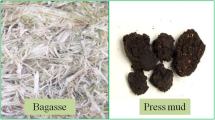Abstract
Sugarcane bagasse is produced by sugar mills as a by-product during cane processing. It is a rich source of several chemical components like lignin, cellulose, hemicelluloses, ash, etc. Bagasse being fibrous in nature retains moisture content for a longer period and can enrich the organic carbon and nutrients available in soil to the plant. In the present study, the utility of sugarcane bagasse as a natural cost-effective medium for raising sugarcane nurseries and transplanting the raised settlings in the main fields in sub-tropical India was attempted. Single bud setts of promising sugarcane varieties CoS 13235, CoSe 13452, and CoLk 14201 were used. The single bud settlings were raised in the poly tray and the mediums used for raising settlings from single bud sett comprised of seven different treatments as T1 = sugarcane bagasse alone, T2 = sugarcane bagasse + compost (3:1), T3 = sugarcane bagasse + press mud (3:1), T4 = sugarcane bagasse + soil (3:1), T5 = soil alone, T6 = soil, sand, and compost (1:1:1), and T7 = coco peat alone. The results revealed that the germination percent was achieved maximum (97 percent) in T1 followed by (T2) treatment (95 percent). However, the settlings produced in treatment T2 were lush green and healthier than treatment T1. Bagasse medium produced remarkable promising results in terms of germination and survival of the settlings after transplanting in the field as compared to the other treatments. Our study suggests that sugarcane bagasse can be used as an efficient and effective medium for growing sugarcane nurseries of promising cultivars.





Similar content being viewed by others
References
Anonymous, 2008.https://www.celignis.com/feedstock.php?value=13
Anonymous.2011. http://www.agsri.com/images/documents/symposium_1/SSI%20Seminar%20Papers%20-%20Draft.pdf
Chacha, M.S., B. Andrew, and M. Rao. 2019. Soil amendments with sugarcane bagasse and its effect on soil humic acid contents and chinese cabbage growth components. Agriculture Research & Technology 21 (3): 117–123. https://doi.org/10.19080/ARTOAJ.2019.21.556166.
Hayman, D.S. 1970. Endogone spore numbers in soil and vesicular-arbuscular mycorrhiza in wheat as influenced by season and soil treatment. Transactions of British Mycological Society 54: 53–63.
Kameyama, K., T.Miyamoto,and Y. Shinogi. 2010. Increase in available water content of soils by applying bagasse-charcoals. 19th World Congress of Soil Science, Soil Solutions for Changing World, 1–6 August, Brisbane, Australia.
Linderman, R.G., and E.A. Davis. 2001. Comparative response of selected grapevine root stocks and cultivars to inoculation with different mycorrhizal fungi. American Journal of Enolology and Viticulture 52: 8–11.
Meunchang, S., S. Panichsakpatana, and R.W. Weaver. 2005. Co-composting of filter cake and bagasse; by-products from sugar mill. Bioresource Technology 96: 437–442.
Moreira, D.R., and V.J.M. Cardoso. 1998. Effect of soil moisture content and the irrigation frequency on the sugarcane germination. Pesquisa Agropecuária Brasileira 33 (5): 721–729.
Robert, N.C., and R.D. Ronny. 2012. Best management practices for Saline and sodic turfgrass soils: assessment and reclamation, 1st ed., 496. Taylor & Francis Group, London: CRC Press.
Singh, P. 2020. Sugar industry: a hub of useful bio-based chemicals. In Sugar and sugar derivatives: changing consumer preferences, ed. N. Mohan and P. Singh. Singapore: Springer.
Singh, P., and J. Singh. 2020. Sugarcane and sugar diversification: opportunities for small-scale entrepreneurship. In Sugar and sugar derivatives: changing consumer preferences, ed. N. Mohan and P. Singh. Singapore: Springer.
Singh Priyanka., A. Bhatnagar, M.M.Singh and J.Singh. 2019. Time of planting impacts yield and quality attributes of sugarcane in sub-tropical India. In proc. of International conference Sugarcon-2019 on Green technologies for sustainable development of sugar & integrated industries. Feb 16-19,2019, ICAR-IISR, Lucknow, India. B-III-O-7:107.
Stantiford, E.I. 1987. Recent developments in composting. In Compost, Production, Quality, and Use, ed. M. Debertoldi, M.L. Ferranti, P. Hermite, and F. Zucconi, pp. 52–60. London, UK: Elsevier.
Tanwar, A., A. Kumar, C. Mangla, and A. Aggarwal. 2010. Mass multiplication of Glomus mosseae using different hosts and substrates. Journal of Mycology and Plant Pathology 40: 306–308.
Tanwar, A., A. Aggarwal, and V. Parkash. 2013. Sugarcane bagasse: a novel substrate for mass multiplication of funneliformis mosseae with onion as host. Journal of Central European Agriculture 14 (4): 1502–1511.
Waheed, Q.M., S. Maqsood, Rashid Nawaz, and Anas Bin Aqeel. 2015. Investigation of thermal behaviour and kinetic analysis of Pakistani biomass: rice husk, sugarcane bagasse and wheat straw using thermo-gravimetric analysis. Power Generation System and Renewable Energy Technologies 2015: 1–7.
Yusuf M., Sarjiyah, and Mulyono. 2018. Effects of appropriate composition of sugarcane bagasse compost and nitrogen fertilizer on the growth and yield of soybean (Glycine max L. Merill). Advances in Engineering Research, volume 172, 4th International conference on food and agriculture resources (FANRes 2018) 126–132.
Author information
Authors and Affiliations
Corresponding author
Additional information
Publisher's Note
Springer Nature remains neutral with regard to jurisdictional claims in published maps and institutional affiliations.
Rights and permissions
About this article
Cite this article
Singh, P., Singh, P. & Singh, J. Sugarcane Bagasse: A Potential and Economical Source for Raising Sugarcane Nursery in Sub-tropical India. Sugar Tech 23, 1211–1217 (2021). https://doi.org/10.1007/s12355-021-01028-9
Received:
Accepted:
Published:
Issue Date:
DOI: https://doi.org/10.1007/s12355-021-01028-9




